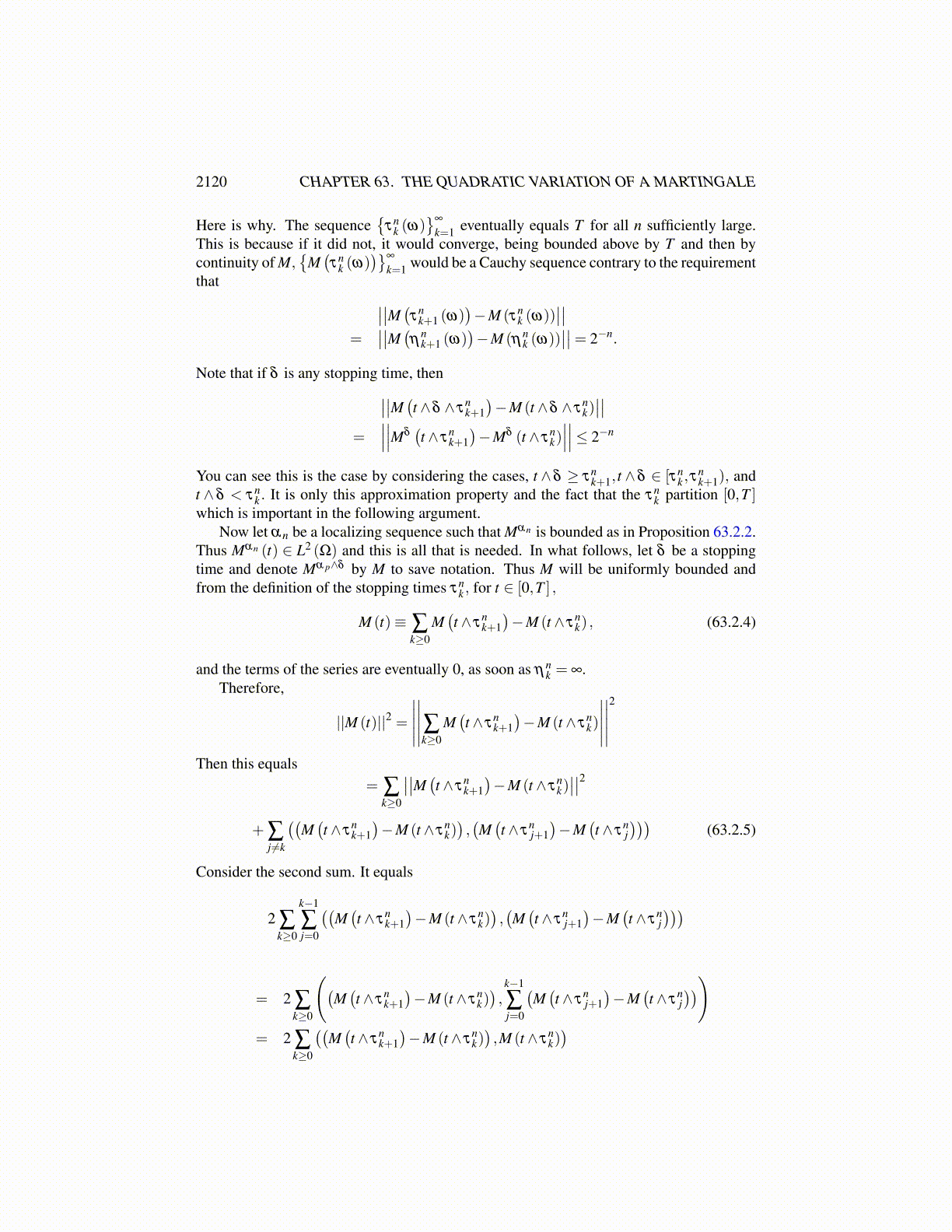
2120 CHAPTER 63. THE QUADRATIC VARIATION OF A MARTINGALE
Definition 63.2.1 Let {M (t)} be adapted to the normal filtration Ft for t > 0. Then itfollows that {M (t)} is a local martingale (submartingale) if there exist stopping timesτn increasing to infinity such that for each n, the process Mτn (t) ≡ M (t ∧ τn) is a mar-tingale of a submartingale with respect to the given filtration. The sequence of stoppingtimes is called a localizing sequence. The martingale Mτn is called the stopped martingale. Exactly the same convention applies to a localized submartingale.
Proposition 63.2.2 If M (t) is a continuous local martingale (submartingale) for a nor-mal filtration as above, M (0) = 0, then there exists a localizing sequence τn such thatfor each n the stopped martingale(submartingale) Mτn is uniformly bounded. Also if Mis a martingale, then Mτ is also a martingale (submartingale). If τn is an increasing se-quence of stopping times such that limn→∞ τn =∞, and for each τn and real valued stoppingtime δ , there exists a function X of τn∧δ such that X (τn∧δ ) is Fτn∧δ measurable, thenlimn→∞ X (τn∧δ )≡ X (δ ) exists for each ω and X (δ ) is Fδ measurable.
Proof: First consider the claim about Mτ being a martingale (submartingale) when Mis. By optional sampling theorem,
E (Mτ (t) |Fs) = E (M (τ ∧ t) |Fs) = M (τ ∧ t ∧ s) = Mτ (s) .
The case where M is a submartingale is similar.Next suppose σn is a localizing sequence for the local martingale(submartingale) M.
Then defineηn ≡ inf{t > 0 : ||M (t)||> n} .
Therefore, by continuity of M, ||M (ηn)|| ≤ n. Now consider τn ≡ ηn ∧σn. This is anincreasing sequence of stopping times. By continuity of M, it must be the case that ηn→∞.Hence σn∧ηn→ ∞.
Finally, consider the last claim. Pick ω. Then X (τn (ω)∧δ (ω))(ω) is eventually con-stant as n→ ∞ because for all n large enough, τn (ω) > δ (ω) and so this sequence offunctions converges pointwise. That which it converges to, denoted by X (δ ) , is Fδ mea-surable because each function ω → X (τn (ω)∧δ (ω))(ω) is Fδ∧τn ⊆ Fδ measurable.
One can also give a generalization of Lemma 63.1.5 to conclude a local martingalemust be constant or else they must fail to be of bounded variation.
Corollary 63.2.3 Let Ft be a normal filtration and let A(t) ,B(t) be adapted to Ft , con-tinuous, and increasing with A(0) = B(0) = 0 and suppose A(t)−B(t)≡M (t) is a localmartingale. Then M (t) = A(t)−B(t) = 0 a.e. for all t.
Proof: Let {τn} be a localizing sequence for M. For given n, consider the martingale,
Mτn (t) = Aτn (t)−Bτn (t)
Then from Lemma 63.1.5, it follows Mτn (t) = 0 for all t for all ω /∈ Nn, a set of measure0. Let N = ∪nNn. Then for ω /∈ N, M (τn (ω)∧ t)(ω) = 0. Let n→ ∞ to conclude thatM (t)(ω) = 0. Therefore, M (t)(ω) = 0 for all t.
Recall Example 62.7.10 on Page 2085. For convenience, here is a version of what itsays.